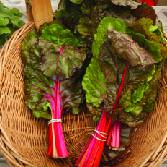-
CATEGORY ::
- All Seeds /
- All Grass Seed /
- All Lawn Seed Mixes


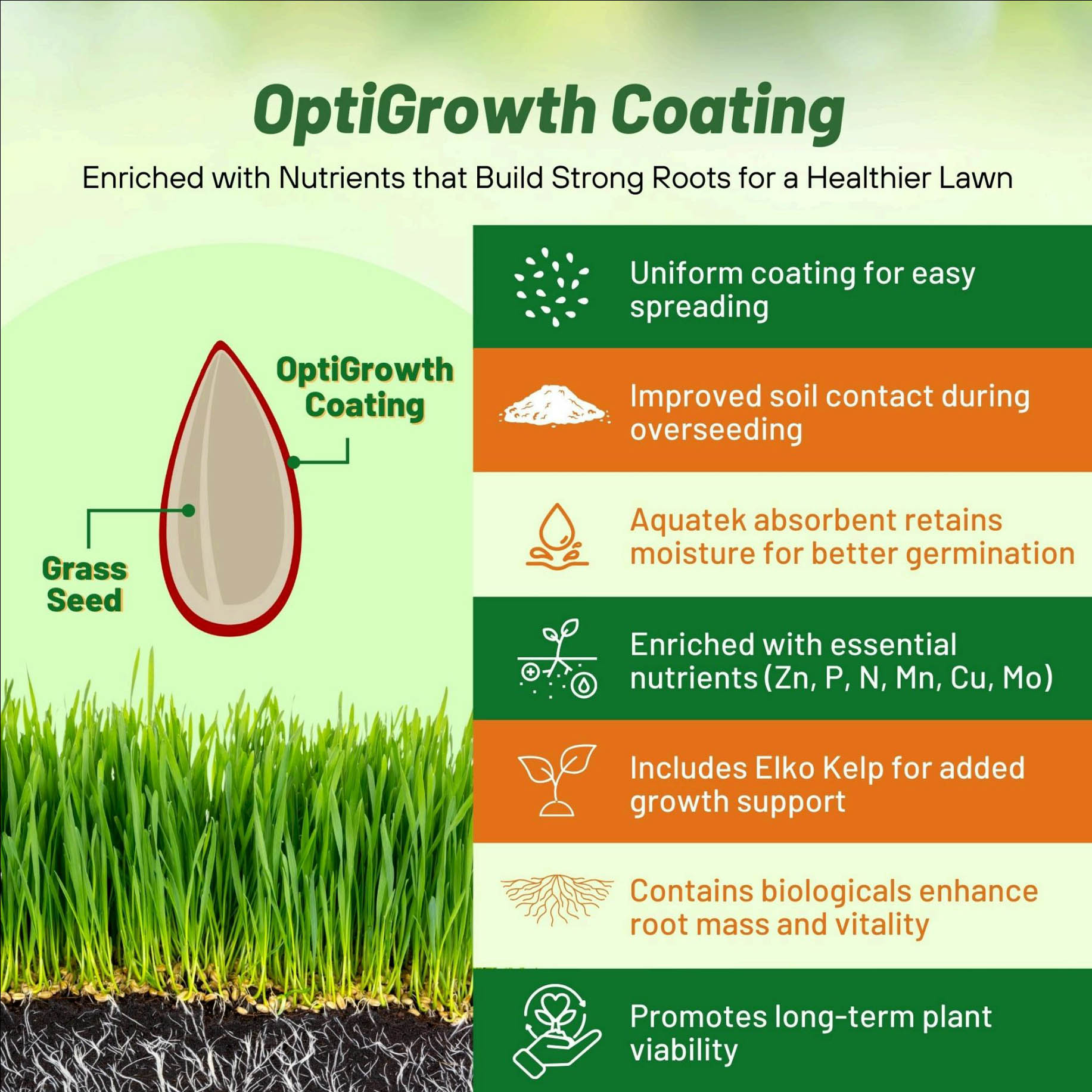

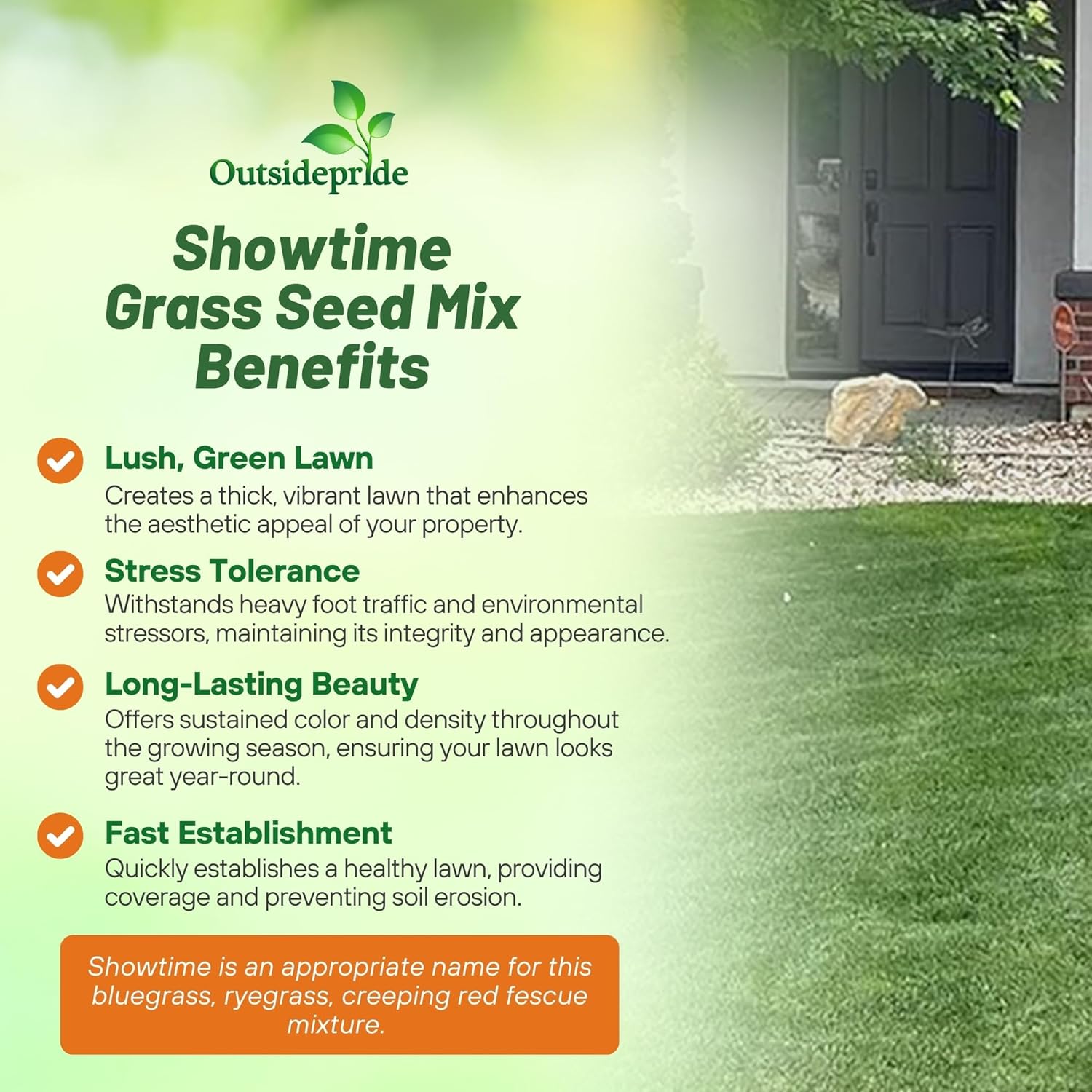

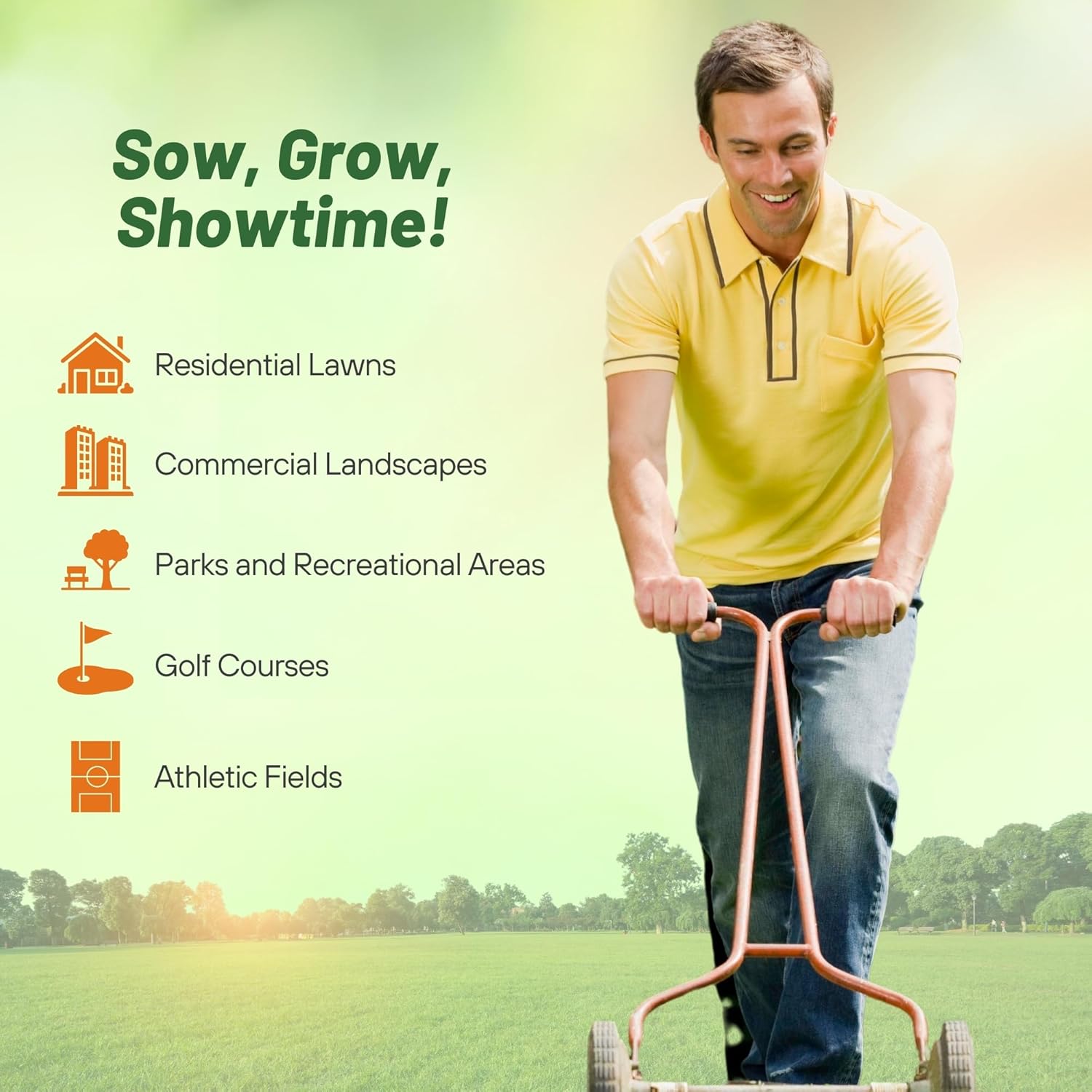




Showtime Grass Seed Mix w/ OptiGrowth
About...
Showtime grass seed mix is a blend of bluegrass, ryegrass and creeping red fescue which makes it shade and wear tolerant and perfect for playing outdoor sports on.MORE LAWN MIXES OPTIONS
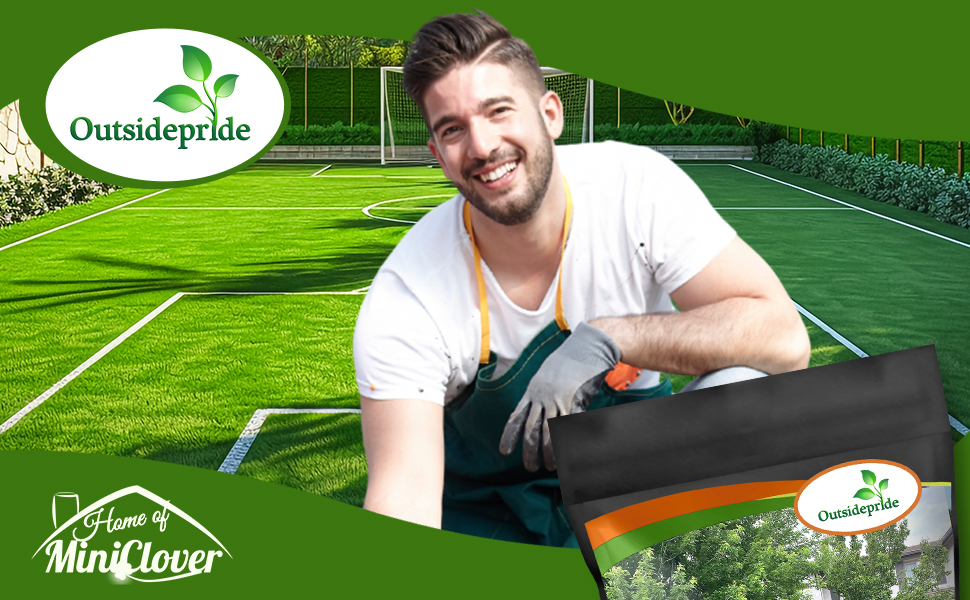
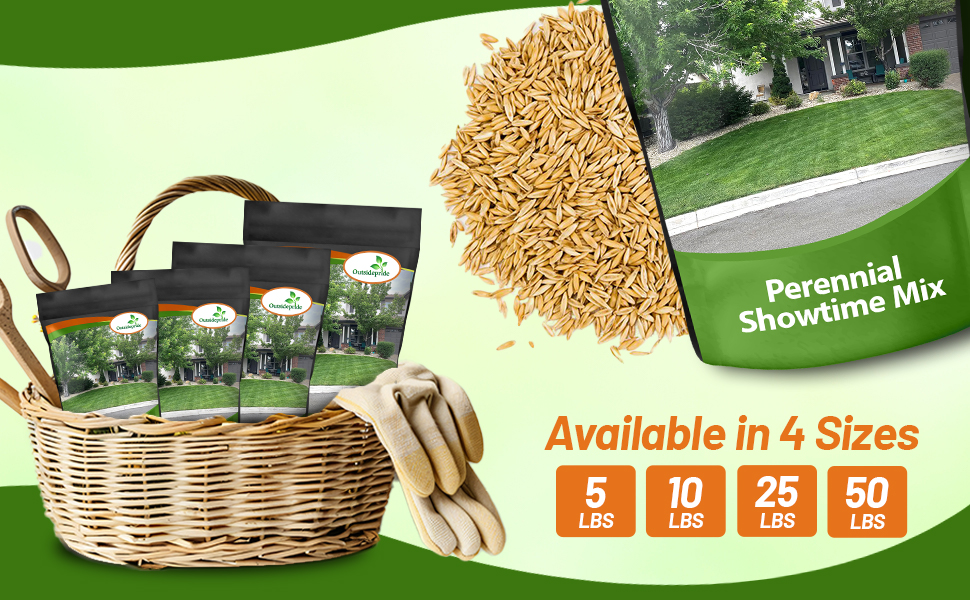







"Showtime" is an appropriate name for this bluegrass, ryegrass, creeping red fescue mixture. This mixture is shade tolerant and wear tolerant for the perfect turf to play volleyball, badminton, croquet, or other outdoor sports on. This mixture makes a soft lawn or sports field that is easy and comfortable to walk on barefoot. If you have a Showtime lawn your neighbors will want one too! Your mixture will consist of one variety of ryegrass, one variety of bluegrass, and one variety of creeping red fescue from the list below specifically selected for the North Half of the U.S. (USDA Zones 4 - 7).
This mixture approximately contains the following:
- 50-55% Ryegrass
- 25-30% Fine Fescue
- 20% Kentucky Bluegrass
Private Perennial Ryegrass
Private is a new generation, heat and disease tolerant, decumbent, very dark green, photoperiod sensitive, endophyte enhanced (>90%) perennial ryegrass variety. Private can be utilized in all perennial ryegrass applications but will be promoted in the transitional climates where heat and disease have been limiting factors to permanent perennial ryegrass turf utilization. Private forms a leafy fine textured turf with rapid seedling germination, excellent traffic tolerance and polyspecies compatibility. Plant growth of perennial ryegrass is dominated by aggressive basal tillering in contrast to vegetative stolons (above ground) and rhizomes (below ground).
Fireball Perennial Ryegrass
Fireball is an elite, new and improved, heat and disease tolerant, very dark green, fine bladed variety. Fireball is an endophyte enhanced perennial ryegrass with >94% Neotyphodium lolii endophyte which provides resistance to a number of leaf and crown feeding insects and nematodes. It is highly recommended for permanent turf utilization in areas where heat and humidity may limit the adaptation of perennial ryegrass turf. In addition Fireball is recommended for winter overseeding of dormant warm season turfgrass species. Plant growth of perennial ryegrass is dominated by aggressive basal tillering in contrast to vegetative stolons (above ground) and rhizomes (below ground).
TeeLee Perennial Ryegrass
A brand new perennial ryegrass released from Bailey Seed Company, TeeLee is showing outstanding growth characteristics, disease resistance, stress tolerance, and recuperative characteristics in East Coast states and the surrounding area. TeeLee ranked very high in the lastest NTEP trials for multiple categories.
Creeping Red Fescue
Creeping red fescue is a very dark green, fine-leaf textured, aggressively rhizomatous variety of strong creeping red fescue. It exhibits an upright-crown growth habit and remains distinctly dark green and is aesthetically pleasing when managed under moderate drought stress. Fine Fescue has excellent seedling vigor and is best adapted to shady sites where low fertility and moderately low soil pH conditions dominate. Fine fescues require soil with good internal drainage for optimal turf performance.
Kentucky Bluegrass
Probably the most outstanding feature of Kentucky bluegrass is its extreme cold tolerance. That is why we have added it to our Showtime blend for the areas where cold tolerance can be of the utmost importance. Its high tiller density provides a thick carpet that will stand up to the abuses of athletic fields and high traffic. Bluegrass blends well with other grasses and makes it softer in appearance and more dense. It is wear tolerant and repairs itself by rhizomes improving its turf density. Bluegrass also provides a dark blue-green color that when added to perennial rye grass and creeping red fescue creates a richly colored turf.
Seeding Rate & Planting Time
- New turf: 4 - 6 pounds per 1,000 square feet or 160 - 240 lbs/acre for broadcast seeding
- Overseeding: 2 - 3 pounds per 1,000 square feet or 80 - 120 lbs/acre for broadcast overseeding
- Plant when soil temperature reaches 55 degrees in spring up until a minimum of 8 weeks before frost in fall
Planting Guide
SOWING TEMPERATURE
55F+
WHEN TO PLANT
Spring 55F or up to 8 weeks before first frost
AVERAGE GERM TIME
12 - 35 days
DAYS TO FIRST MOWING
28 - 45 days
PLANTING DEPTH
Surface to 1/4 Inch
SOWING METHOD
Broadcast or Drill
MOWING HEIGHT
2.5 - 3 Inches
ENVIRONMENT
Full Sun
ZONES
3 - 7
Grass Specifications
IDEAL FOR
Lawns
PLANT CHARACTERISTICS
Fine Bladed, Dark Green
ESTABLISHMENT RATE
Slow
MOISTURE REQUIREMENTS
Moderate to High
ACIDIC SOIL TOLERANCE
Medium
SALINITY TOLERANCE
Low - Moderate
COLD TOLERANCE
Medium to High
SHADE TOLERANCE
Poor to Moderate
WEAR TOLERANCE
Low to Medium
THATCH TENDANCY
Medium
FERTILITY NEEDS
Low to Medium
SEASON
Perennial

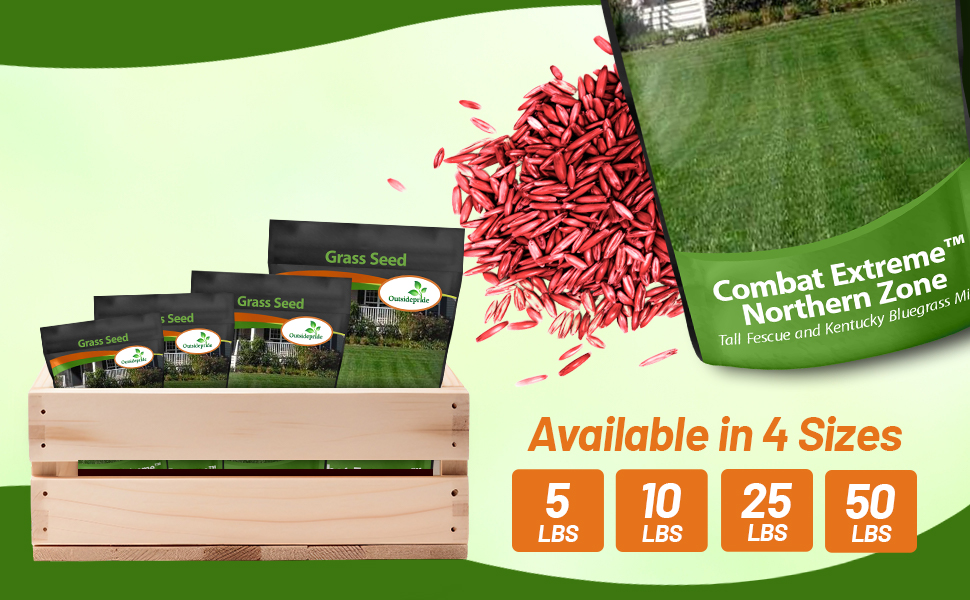
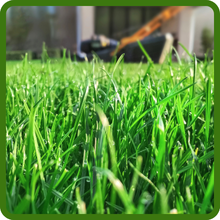

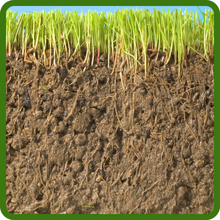

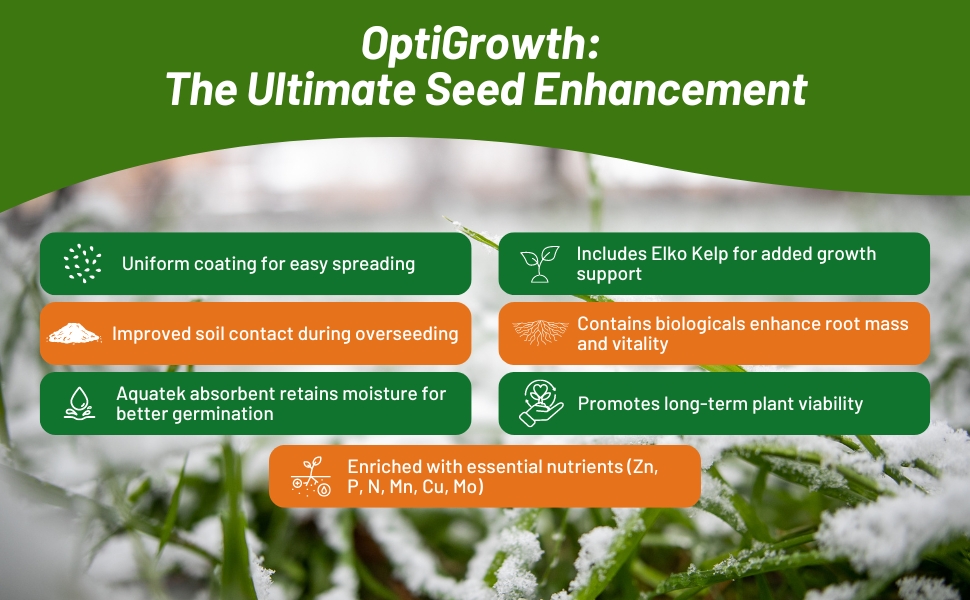

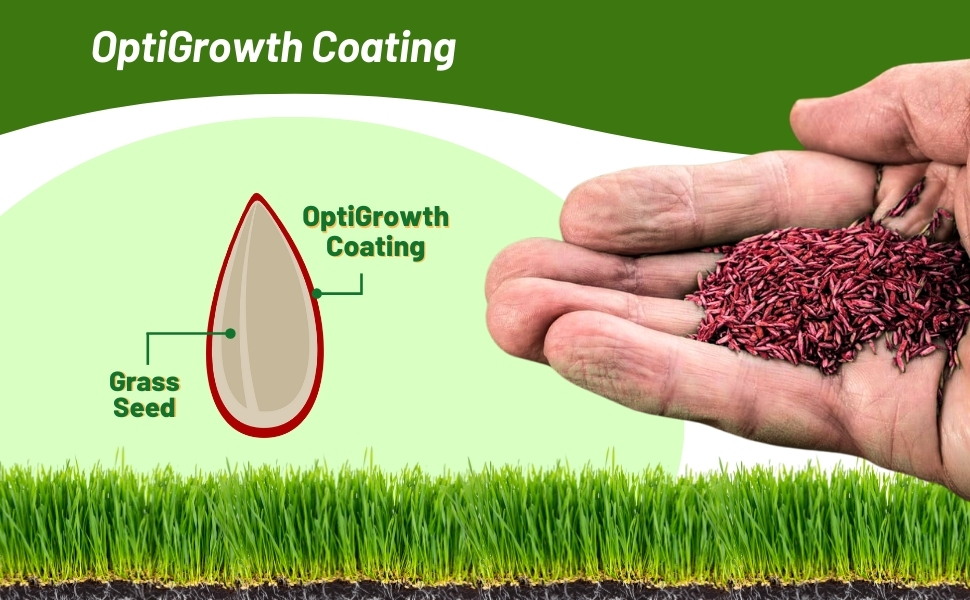
Combat Extreme™ Northern Zone - This tall fescue and Kentucky Bluegrass mix produces fine to medium leaf blades which allows a dense turf to form. This grass seed mix uses lower-growing cultivars which means that mowing requirements and clipping yields can be reduced up to 30 percent. Combat Extreme™ Northern Zone grass seed establishes rapidly when soil temperatures are above 55 degrees Fahrenheit. The varieties of turf type fescue grass were selected due to their ability to withstand hot summer temperatures as well as cold and harsh winters in USDA Zones 4 - 5. Combat Extreme™ Northern Zone grass seed has improved germination which allows it to establish more quickly than other varieties and its lower growth habit significantly reduces the amount of top growth. It does extremely well in full sun or partial shade in USDA Zones 4 - 5. Combat Extreme™ Northern Zone grass has the addition of Kentucky Bluegrass for extra cold tolerance and turf density. Combat Extreme™ Northern Zone grass seed an excellent choice for professional or home use.
Three Combat Blends To Optimize Varieties:
- Combat Extreme Northern Zone - USDA Zones 4 - 5
- Combat Extreme Transition Zone - USDA Zones 6 - 7
- Combat Extreme Southern Zone - USDA Zones 8 - 10
Each Combat Extreme mixture will perform well outside of the given zone. For example, there is no reason you could not use Combat Extreme Transition Zone in USDA Zone 8 or Combat Extreme Northern Zone in USDA 6. These USDA Zones are given as optimal guidelines, but not as fixed rules.Combat Extreme grass seed is one of the few tall fescue grass lawn seed blends available that is 100% weed free!
Seed size is much larger for turf fescue than Kentucky Bluegrass; therefore, by weight this is a 90%/10% fescue/bluegrass blend, but by seed count it is a pretty equal blend.
Unlike other turf type tall fescue grass seeds, Combat Extreme has the ability to repair itself. Traditional tall fescue grass will clump together, not filling in the bare spots and producing an uneven lawn. With bare spots, weeds are more apt to take over the lawn. What makes Combat Extreme™ Northern Zone grass seed unique is its ability to fill in these open areas with through aggressive tillering.
Another great feature of Kentucky bluegrass is its extreme cold tolerance. That is why we have added it to our regular Combat Extreme blend for the USDA Zones 4-5 where cold tolerance can be of the utmost importance. Bluegrass blends well with turf type fescue and makes it softer in appearance and more dense. Midnight Kentucky bluegrass was also developed with quick establishment in mind. It is wear tolerant and repairs itself by rhizomes and tillering improving its turf density.Characteristics of Combat Extreme™ Northern Zone
| Self-repairing turf |
|
|---|---|
| Strong, deep root system |
|
| Produces a thick even lawn grass |
|
| Excellent color and disease resistant |
|
| Rapid germination and quick spring green-up |
|
| Higher value for the home owner than conventional tall fescue grass seed |
|
Mixing varieties together that have top performance on some of the desired characteristics allows the lawn to adapt itself to various conditions. In the shady areas, the grass seed varieties with good shade tolerance will prevail, in the high traffic areas the best wear tolerant grass seed varieties will prevail, etc. The result is a beautiful lawn grass everywhere, from the same grass seed blend.
Combat Extreme™ grass seed sets a new standard for home lawns. Not only is the Combat Extreme™ Northern Zone grass seed a blend of top performing seed varieties, now it has the ability to repair itself through outstanding tillering characteristics as well as requiring less water and fertilizer. That is why Combat Extreme™ Northern Zone grass seed is the only seed you’ll ever need! In our opinion, this is the best grass that we carry (for durability and hardiness) and the best tall fescue and bluegrass mix on the market today!
Seeding Rate & Planting Time
- New turf: Sow 6 - 8 pounds Combat grass seed per 1,000 square feet or 240 - 320 lbs/acre for broadcast seeding
- Over-seeding: Sow 3 - 4 pounds Combat Extreme™ cold climate grass seed per 1,000 square feet or 120 - 160 lbs per acre for broadcast over-seeding
- Plant cold climate grass seed when soil temperature reaches 55 degrees in spring up until a minimum of 6 weeks before frost in fall
Planting Guide
SOWING TEMPERATURE
55F+
WHEN TO PLANT
Spring 55F or up to 6 weeks before first frost
AVERAGE GERM TIME
7 - 14 Days
DAYS TO FIRST MOWING
21 - 30 Days
PLANTING DEPTH
Surface to 1/8 Inch
SOWING METHOD
Broadcast or Drill
MOWING HEIGHT
2.5 - 3 Inches
ENVIRONMENT
Full Sun to Partial Shade
ZONES
3 - 8
Grass Specifications
IDEAL FOR
Lawns, Parks, Recreation Fields
PLANT CHARACTERISTICS
Wear Tolerance, Medium Bladed
ESTABLISHMENT RATE
Moderate
MOISTURE REQUIREMENTS
Low to Moderate
ACIDIC SOIL TOLERANCE
High
SALINITY TOLERANCE
Low
COLD TOLERANCE
Medium
SHADE TOLERANCE
Good to Excellent
WEAR TOLERANCE
Medium to High
THATCH TENDENCY
Low
FERTILIZER NEEDS
Low to Medium
SEASON
Perennial


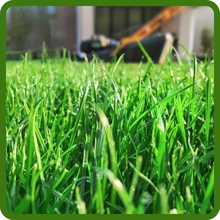



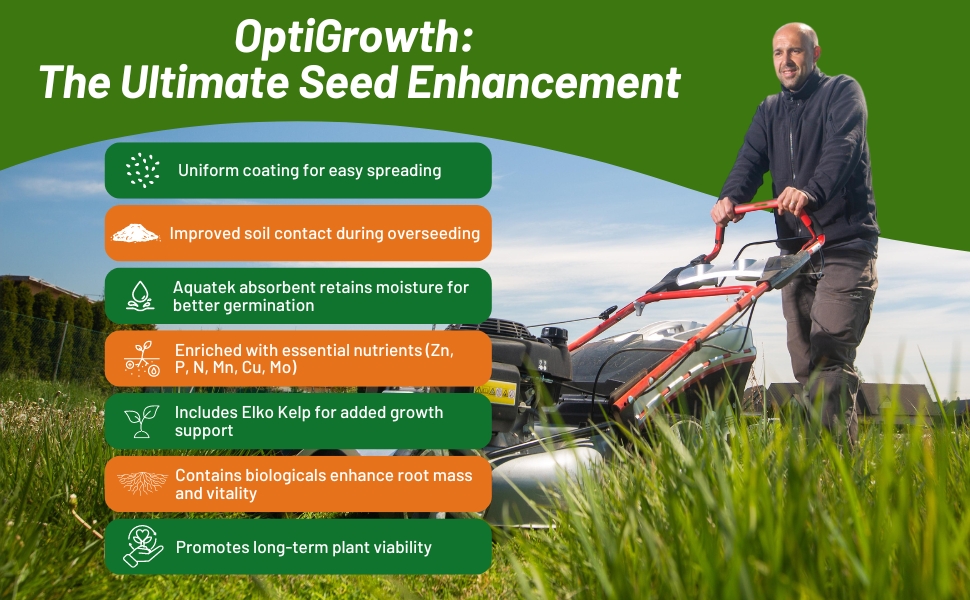
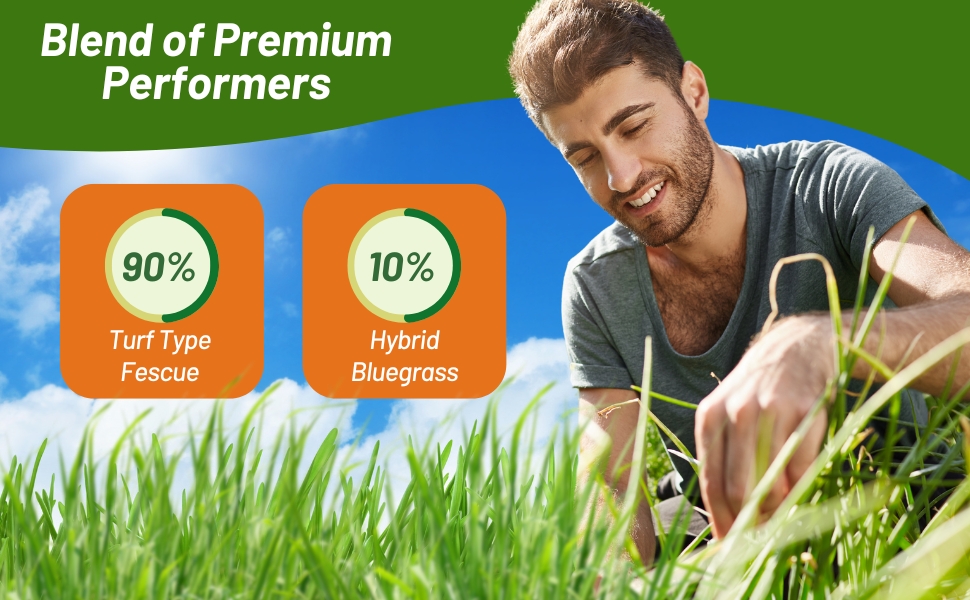

The bluegrass hybrid that is in Combat Extreme™ grass seed mix is SPF 30. It is a cross between Kentucky bluegrass (Poa pratensis) and Texas bluegrass (Poa arachnifera), and it is well suited for bluegrass turf applications for improved heat and drought tolerance. SPF 30 features a low-growing, moderately dense growth habit with a medium, bright green color and a medium-fine leaf texture and offers improved shade tolerance. SPF 30 mixes well with most other cool-season grasses such fine fescue, Kentucky bluegrass, perennial ryegrasses, and tall fescue. Because of its Texas bluegrass component, SPF 30 is well suited for areas with temperate to hot summers and more temperate winters. It is well suited to mixes with turf-type tall fescues, affording improved density and recovery from damage. SPF 30 has exhibited the following characteristics:
Why Combat Extreme™ Southern
- Excellent heat tolerance. This grass, in fact, seems to grow better the warmer it gets in the summer. The growth and vigor of most Kentucky bluegrass varieties will generally decline under high heat (upper 80s-100s), which can reduce its traffic and wear tolerance during the hottest times of the growing season. The Texas hybrid blue grass appears to maintain more active summer growth, which translates into better traffic tolerance and ability to recover from traffic injury.
- Deep and extensive root production. These hybrids produce an extensive root system, which enhances heat and drought resistance. A dense root system will also improve traffic tolerance, ability to recover from wear, and will improve footing (traction) in a sports turf application.
- Extensive and aggressive rhizome formation. These grasses form large, extensive and aggressive rhizomes (underground stems). Different from roots, rhizomes contain growing points that produce new grass plants. Grasses that produce rhizomes are better able to tolerate traffic and will recover more quickly from traffic-induced wear – often without the need to re-seed the worn areas. An aggressive rhizome system also means better traction in a sports turf situation.
- Low mowing height tolerance. Its excellent heat tolerance and aggressive root and rhizome formation characteristics allow this grass, when necessary, to be mowed at lower heights than many Kentucky blue grasses – especially during the heat of summer. This can be important for “showcase” sports turf applications.
- Potential to require less irrigation. There is a good anecdotal field evidence to suggest that the hybrid blue grasses require less irrigation than some of the Kentucky blue grasses, and perhaps less than the turf-type tall fescues. This ability to sustain growth and vigor with less irrigation is likely due to its ability to form deeper roots than most other blue grasses, and its excellent heat tolerance.
Three Combat Blends To Optimize Varieties:
- Combat Extreme Northern Zone - USDA Zones 4 - 5
- Combat Extreme Transition Zone - USDA Zones 6 - 7
- Combat Extreme Southern Zone - USDA Zones 8 - 10
Each Combat Extreme™ mixture will perform well outside of the given zone. For example, there is no reason you could not use Combat Extreme™ Transition Zone in USDA Zone 8 or Combat Extreme™ Northern Zone in USDA 6. These USDA Zones are given as optimal guidelines, but not as fixed rules.
Characteristics of Combat Extreme™
| Self-repairing turf |
|
|---|---|
| Strong, deep root system |
|
| Produces a thick even lawn grass |
|
| Excellent color and disease resistant |
|
| Rapid germination and quick spring green-up |
|
| Higher value for the home owner than conventional tall fescue grass seed |
|
Blending fescue grass seed varieties together that have top performance on some of the desired characteristics allows the lawn to adapt itself to various conditions. In the shady areas, the grass seed varieties with good shade tolerance will prevail, in the high traffic areas the best wear tolerant grass seed varieties will prevail, etc. The result is a beautiful lawn grass everywhere, from the same grass seed mix. This is especially true when combined with SPF-30 hybrid bluegrass. SPF-30 is is extremely heat and drought tolerant as well as shade tolerant.
Combat Extreme™ fescue grass seed sets a new standard for home lawns. Not only is the Combat Extreme™ grass seed a blend of top performing seed varieties, now it has the ability to repair itself through outstanding tillering characteristics as well as requiring less water and fertilizer. That is why Combat Extreme™ grass seed is the only seed you’ll ever need! In our opinion, this is the best grass that we carry (for durability and hardiness) and the best tall fescue and bluegrass mix on the market today!
Seeding Rate & Planting Time
- New turf: Sow 6 - 8 pounds turf seed per 1,000 square feet or 240 - 320 lbs/acre for broadcast seeding
- Over-seeding: Sow 3 - 4 pounds lawn seed per 1,000 square feet or 120 - 160 lbs per acre for broadcast over-seeding
- Plant Combat Extreme™ grass seed when soil temperature reaches 55 degrees in spring up until a minimum of 6 weeks before frost in fall
Planting Guide
SOWING TEMPERATURE
55F+
WHEN TO PLANT
Spring 55F or up to 6 weeks before first frost
AVERAGE GERM TIME
7 - 14 Days
DAYS TO FIRST MOWING
21 - 30 Days
PLANTING DEPTH
Surface to 1/8 Inch
SOWING METHOD
Broadcast or Drill
MOWING HEIGHT
2.5 - 3 Inches
ENVIRONMENT
Full Sun or Partial Shade Zones 9 - 10
ZONES
3 - 10
Grass Specifications
IDEAL FOR
Lawns, Parks, Recreation Fields
PLANT CHARACTERISTICS
Wear Tolerance, Medium Bladed
ESTABLISHMENT RATE
Mod
MOISTURE REQUIREMENTS
Low to Moderate
ACIDIC SOIL TOLERANCE
High
SALINITY TOLERANCE
Low
COLD TOLERANCE
Medium
SHADE TOLERANCE
Good to Excellent
WEAR TOLERANCE
Medium to High
THATCH TENDANCY
Low
FERTILITY NEEDS
Low to Medium
SEASON
Perennial
Our Xeriscape Flowering Lawn Seed Mix is the ideal solution for a resilient, pollinator-friendly lawn. This mix will provide an attractive green lawn with a soft, cushiony feel underfoot, while blooms nourish pollinators if left unmowed. Drought resistant native red fescue, blue grama, alkaliagrass, and Canada bluegrass thrive in dry, hot, and cold conditions as well as poor soils. Mow for a traditional tidy look, or skip mowing for a flowering meadowscape.
Approximate Percentage:
- 32% Native Red Fescue
- 10% Blue Grama
- 6% Dwarf Wildflower Seed Mix
- 2% Alkaligrass
- 1% Canada Bluegrass
Mix includes corn grit to make it easier to spread and retain moisture throughout the germination process. This xeriscape flowering lawn seed mix will grow in USDA Zones 2 - 9 in full sun to partial shade. Begin growing this hardy lawn seed mix today and enjoy these benefits:
- Bee friendly
- Attracts butterflies
- Can be used as a ground cover
- Very low maintenance
- If left to flower it will flower a long time
- Is great for mass plantings and very economical
- Naturalizes any area
- Can be used for rock gardens and erosion control
Seeding Rate: 2 - 3 lbs per 1,000 SF
Planting Guide
SOWING TEMPERATURE
55F+
WHEN TO PLANT
Spring 55F or up to 8 weeks before first frost
AVERAGE GERM TIME
7 - 28 Days
DAYS TO FIRST MOWING
21 - 30 days
PLANTING DEPTH
1/8 to 1/4 inch
SOWING METHOD
Broadcast
MOWING HEIGHT
2.5 - 3 inches
ENVIRONMENT
Full Sun
ZONES
2 - 9
Grass Specifications
IDEAL FOR
Lawns, Low Maintenance Areas
PLANT CHARACTERISTICS
Resilient, Pollinator-friendly
ESTABLISHMENT RATE
Slow - Moderate
MOISTURE REQUIREMENTS
Low
ACIDIC SOIL TOLERANCE
Medium
SALINITY TOLERANCE
Low
COLD TOLERANCE
Medium to High
SHADE TOLERANCE
Good to Excellent
WEAR TOLERANCE
Low
THATCH TENDANCY
Low to Medium
FERTILITY NEEDS
Low
HEIGHT
SEASON
Perennial
















